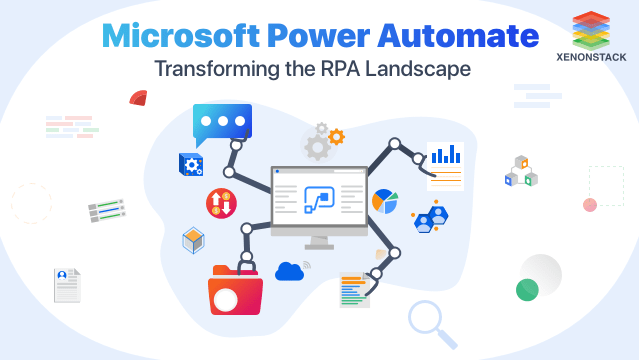
Microsoft Power Automate: Streamlining Business Process Automation
Automation no longer constitutes a moonshot. Survival in our ever more technology-driven market world is required. Yet, 22 percent of businesses still lack process excellence, and workflows' automation has been figured out. RPA (Robotic Process Automation), is the primary building block in this industry. The demand for RPA is the fastest and most competitive enterprise software demand. And in this tool market, Microsoft has also introduced a tool.
Microsoft's MS Flow is now Microsoft Power Automate, the cloud-based workflow engine for Windows. They can automate any process or task quickly. This allows workers to simplify processes with linked sources, such as MS Office 365, easily.
What is Power Automate and How It Works?
Microsoft Flow, now known as Microsoft Power Automate, is a cloud-based software that enables employees to create and automate the workflows and tasks across multiple applications and services, with no developer assistance. The flows are called automatic workflows. To create a flow, the user determines what action to take when a specific event occurs.
The digitization of work at this new scale will cause tech leaders to rethink enterprise security and the increasingly popular zero trust strategy will take center stage. Source: Robotic Process Automation: Predictions For Next Year
This allows for the automation of repetitive routine tasks and processes in different programs/services. This encourages research and makes it more effective. Business process mapping and automation have also been possible only through programming. No standardized IT connectors were present. Until now, workflows could only be realized inside the Office environment with the SharePoint Designer.
The cloud-based Microsoft Power Automate software improves this Build the individual workflow solutions inside and outside the Microsoft Cloud between various services. This increases the degree of automation and thus process efficiency in the company.
Key Features of Microsoft Power Automate for Automation
-
Seamless connections through 302 + of the most common applications for enterprises.
-
Power BI connectors within flows connect to the third-party databases and tap into the business intelligence and analytics.
-
Templates and a no-code interface automate the business processes with only one click.
-
Complex team flow creation, where the project group owns and manages a flow together.
-
The RPA (Robotic Process Automation) tracks step-by-step actions, such as mouse clicks, keyboard usage, and data entry, and then replicates those actions into smart workflows that automatically activate.
-
UI flows that work with the legacy desktop and the web-based applications that lack an API.
-
Quick addition of artificial intelligence through pre-built AI models, without users needing to know a code line.
-
Mobile app-accessibility on Android and iOS for running flows on the go.
Who Can Benefit from Using Power Automate?
Microsoft Power Automate offers a useful tool for:
-
Organizations who want to automate their workflows favor making business operations more efficient and reducing operating costs.
-
IT decision-makers want to allow business partners to create solutions themselves so IT professionals and integration specialists can concentrate on more advanced integration tools.
Types of Flow
Four types of Flow are available in Microsoft Power Automate:
-
Automated Flow: It triggers certain events within a product or service (such as any keyword sent in a message).
-
Instant Flows: Instant Flows triggers when a user clicks a button either on Flow Mobile or on the web site of Microsoft Flow.
-
Scheduled Flows: These triggers once a day, hour, or minute; on the date specified; or after several days, hours, or minutes specified by the user.
-
Business Process Flows: This flow is like wizards, but you need to follow specific business workflows, such as embarking on a new client or updating a particular account from one form of service to another; this type of flow has a visual guide to indicate how far the consumer is at any given moment in the entire process.
Read more about Robotic Process Automation Architecture and Tools
RPA Capabilities in Microsoft Power Automate Explained
The new Power Automate RPA function is called UI flows. By recording and playing back the human-driven interaction with software systems that do not support API automation, the RPA function transforms manual tasks into automated workflows. Since Microsoft Power Automate has pre-constructed connectors for over 275 applications and services that support API automation, Microsoft argues that it now has an end-to-end automation platform "capable of reinventing business processes for a wide range of workloads across industries."
Scaling and automating business processes isn't simple — Power Automate is Microsoft's effort to deliver API-based automation and UI-based automation in one platform.
Product Value
For Citizen Developer
-
Using the point-and-click approach of Power Automate to build the workflows and their Excel-like formulas to add functionality
-
Connect to hundreds of sources-old or new-including Dynamics 365, Azure SQL Server, Excel, SharePoint, LinkedIn, Dropbox, and more.
-
Use Power Automate to design logic for your Power Apps.
For IT
-
Prevent sensitive data from leaving your business by applying integrated or personalized data loss prevention policies
-
Link securely to on-site data and cloud-based infrastructure so that you can make the most of your current data
For Developers
-
Use Azure functions within Power Automate to implement custom server-side logic.
-
Take decisions in your workflow, such as only taking action if those requirements match.
For Business Users
-
Help your team be more professional, competitive, and effective with the automation specifically built for your business processes.
-
Automate various manual and repetitive activities – let you have more time for the important things.
Microsoft Power Automate brings 220+ applications and services on board. These include the famous connectors like MS Dynamics, MS Planner, OneDrive for Business, MailChimp, etc.
-
When you're having a conversation within Microsoft Teams, the Flow bot will recognize those phrases (or users will trigger certain phrases manually) to automatically flag something for a manager or send an email to another department, right from within Teams, where the original thought process is taking place.
-
In Microsoft Forms, a survey you generate to send to customers after purchasing your product or using your service can be designed to kick off a flow if a customer's rating is too weak (say, a 4 or 5 out of 10). This Flow will send an email to a boss, text a customer service representative to follow up with the client, or create an apology letter from a template in Office 365.
RPA enables a higher efficiency in human actions with RPA Tools, we get a virtual employee who can perform repetitive activity faster and more cost-effectively than humans. Source: 3 Best RPA Tools: Picking The Right Robotic Process Automation Tool
Top Benefits of Microsoft Power Automate for Businesses
Share and Access Data
Data is quickly transferred from one device to another with the connectors' aid. It enables data exchange and offers easy access to the necessary data.
Quick and Safe Automation
The cloud-based platform empowers anyone with a no-code background to quickly and easily create stable workflows. As easy as just pointing and clicking.
The Integration with other Applications is Easy and Seamless
Microsoft Power Automate enables you to integrate easily with other applications or services through connectors. A connector links two separate applications. Data is "moved" from one program to another in this way.
Bring Intelligence to Workflows
Automate tedious manual tasks with pre-assembled artificial intelligence capabilities. This provides an employee with a focus on more important, more interesting, and challenging tasks.
Improved efficiency
Incorporate flexible workflows, from individual tasks to enormous size processes. Flexibility is evident as an option for doing this manually. Save time and work effectively.
Explore about Acquainting with the Top RPA Open Source Tools Wholly
Limitations and Challenges of Microsoft Power Automate
Like every other platform or program out there, Microsoft Flow also has some vulnerability, which many have pointed out. Among those that are most ubiquitous are:
Inability to Run Multiple Flows Simultaneously
This would inevitably force you to create a new one from scratch, resulting in repetitive work in turn. Although the practice is the best teacher, for many, this flaw is neck pain, especially when it is necessary to define every single exception and variation from scratch. This will result in the cycle of creating flows overly time-consuming and complicated instead of their slogan: "Work less, do more."
No Option to Reorder Steps in a Flow
Microsoft Flow does not provide the ability to reorder specified steps for users. Once you start building, define the first step. However, after adding two-three more to it, you can't go back and add another one between them. Unfortunately, rearranging their order isn't an option either.
Challenges in Reconnecting Flows to New Lists
If a flow has been formed, you cannot "transfer it" or reconnect it to new lists.
For example: When Mark finishes his study, after you have described getting an automatic message, you won't be able to change the same Flow to inform you if Jessica submits her research, too. You will have to go through the steps of developing a new flow specifically for Jessica all over again since the current one will not connect itself and prioritize the newly sent data. Analogously, you cannot re-create a flow-instead of configuring an existing one to meet your needs. You will have to build a new one from scratch.
Lack of Email Formatting for Approval Requests
Whenever creating an approval email, Microsoft Flow can automate the sending process. However, you cannot do any formatting to it.
Click to know more about Robotic Process Automation in Healthcare management
Best Alternative Tools to Microsoft Power Automate
There is a broad range of low-code or codeless automation tools and cloud-based applications that connect devices and automate business and office processes and tasks. The critical competitors to Microsoft Power Automate are IFTTT and Zapier.
IFTTT
If This That is a free web-based tool to automate workflows using simple syntax and conditional statements. Its simplicity makes the roll out simple. IFTTT offers workflows of single actions.
Zapier
It can simplify multi-stage workflows and has more third-party application connections. Zapier has both a free option and two tears of paid monthly business subscription plans.
Future of Workflow Automation with Power Automate
Hence, we can conclude that the Power Automate initiative is revolutionizing. It streamlined the complicated errands and put tons of human obligations on its shoulders. There's no question this is an artificial intelligence privilege. It makes life simpler for Tech-savvy businesses. This is how Microsoft's Power Automate has changed the business's culture.
Next Steps for Implementing Microsoft Power Automate
Talk to our experts about implementing Microsoft Power Automate for workflow automation. Learn how industries leverage RPA (Robotic Process Automation) to streamline processes, enhance workflow efficiency, and improve task automation. Utilize Power Automate to optimize operations, reduce manual effort, and boost responsiveness.


